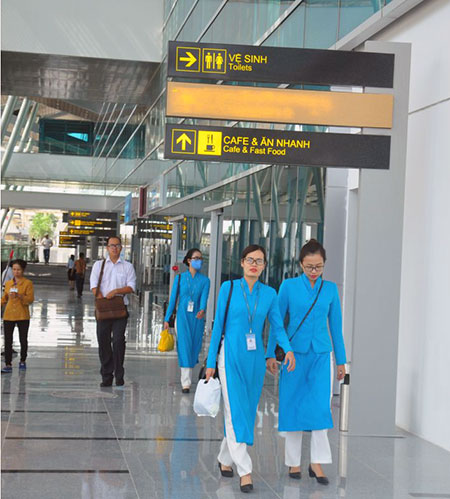New terminal helps city to attract more visitors
Since its operation in May 2017, the 3.5 trillion VND (158 million USD) international passenger terminal at the Da Nang International Airport has prove effective in satisfying the growing air transport demand in Central Viet Nam.
 |
| The international passenger terminal helps to enhance the air passenger transport quality (Photo: DNO/ Thanh Lan) |
The Da Nang International Airport is the 3rd largest of its kind in Viet Nam after Ha Noi’s Noi Bai and Ho Chi Minh City’s Tan Son Nhat.
Notably, the number of air passengers to the city last year jumped by 74,4% against the same period of the pervious year to 1,580,300. By the end of last year, there had been a total of 15 scheduled and 14 charter direct international air routes connecting Da Nang with other destinations worldwide.
According to the Da Nang International Terminal Investment and Operation JSC (AHT), the terminal handles an average of about 70 flight arrivals and departures in total with a sum of about 11,000 international passengers. In particular, it serves 90 flights with over 13,000 passengers in total at peak hours. The majority of the comers are from such foreign countries as South Korea, Japan, Hong Kong, Thailand, Singapore, China and Malaysia.
Given the stable annual growth in the number of air passengers to the city, the city’s airport is aiming to reach its key target of becoming the central region's leading aviation hub in the near future.
 |
| The terminal has been installed with more modern equipment |
Work started on the terminal on 15 November 2015, and it is a key part of city's preparations for the APEC Economic Leaders’ Week (AELW 2017) which took place in the city last November.
The 2-storey terminal covers an area of 21,000m2, giving a total floor area of 48,000m2. It features 20 emigration and 22 immigration counters, 10 boarding gates with 4 skybridges and 6 bus gates, plus 2 baggage loading and 4 baggage unloading areas. There are also a departure lounge area featuring souvenir, and food and drinks stalls,which all allow passengers to relax whilst waiting for their flights.
A 623m-long and 7m-wide vehicle overpass has 2 traffic lanes and 1m-wide pedestrian sidewalks. Covering an area of 41,000m2, the parking area can handle 416 cars and 20 coaches in total.
The modern and fully-equipped terminal has received a high appreciation from foreign passengers. Ms Hyun Jung from South Korea, for instance, said she was very impressed with the terminal. Thanks to the opening of this venue, this South Korean visitor felt comfortable to directly fly to Da Nang from her hometown, without transiting through another airport.
Since the terminal was put into use in May 2017, the Customs Division has effectively handled entry procedures for passengers arriving at the airport through the ‘green and red gates’. The operation of these ‘gates’ is a convenient way to shorten the time to handle entry procedures, and to relieve the passenger overload at the airport.
In addition to the effective operation of the ‘green and red gates’, an underground scanning system for check-in luggage has been put into use at the airport to facilitate the entry of passengers, and shorten time spent on administrative procedures.
The deployment of underground scanning allows all registered baggage of passengers that are entering to be checked via scanner without disassembling and damaging the luggage.
By the end of this year, there will be new direct flights connecting Da Nang with Incheon, Busan and Daegu, all in South Korea, Japan’s Osaka, and Hong Kong, and an expected hike in the volume of air passengers against last year. In addition to such key foreign tourist market as Japan, China and South Korea, new flights connecting the city with India and European countries will open in the coming years.
It is no doubt that the operation of the terminal helps to attract more international visitors, especially investors, coming to Da Nang, thereby helping to accelerate the city’s progress and bring a positive change to the face of the city.